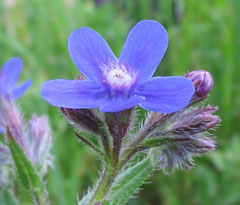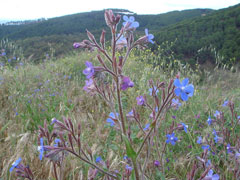 |
|
http://commons.wikimedia.org/wiki/User:Alberto_Salguero |
 |
| http://commons.wikimedia.org/wiki/User:Xemenendura |
Translate this page:
Summary
Physical Characteristics

 Anchusa azurea is a PERENNIAL growing to 1.5 m (5ft) by 0.6 m (2ft in).
Anchusa azurea is a PERENNIAL growing to 1.5 m (5ft) by 0.6 m (2ft in).
See above for USDA hardiness. It is hardy to UK zone 3. It is in flower from June to August, and the seeds ripen from July to September. The species is hermaphrodite (has both male and female organs) and is pollinated by Bees.
It is noted for attracting wildlife.
Suitable for: light (sandy), medium (loamy) and heavy (clay) soils, prefers well-drained soil and can grow in heavy clay soil. Suitable pH: mildly acid, neutral and basic (mildly alkaline) soils. It cannot grow in the shade. It prefers moist soil and can tolerate drought.
UK Hardiness Map
US Hardiness Map
Synonyms
A. italica.
Plant Habitats
Cultivated Beds;
Edible Uses
Edible Parts: Flowers Leaves Shoots
Edible Uses:
Flowers - raw. An excellent and decorative addition to the salad bowl, or used as a garnish[183]. The tender young leaves and young flowering shoots can be cooked and eaten as a vegetable[7].
References More on Edible Uses
Medicinal Uses
Plants For A Future can not take any responsibility for any adverse effects from the use of plants. Always seek advice from a professional before using a plant medicinally.
Antitussive Depurative Diaphoretic Diuretic Poultice
The whole plant is antitussive, depurative, diaphoretic and diuretic[7]. It is harvested when in flower and dried for later use. The dried and powdered herb is used as a poultice to treat inflammations[7]. Use internally with caution, the plant contains the alkaloid cynoglossine which can have a paralyzing effect[7].
References More on Medicinal Uses
The Bookshop: Edible Plant Books
Our Latest books on Perennial Plants For Food Forests and Permaculture Gardens in paperback or digital formats.

Edible Tropical Plants
Food Forest Plants for Hotter Conditions: 250+ Plants For Tropical Food Forests & Permaculture Gardens.
More

Edible Temperate Plants
Plants for Your Food Forest: 500 Plants for Temperate Food Forests & Permaculture Gardens.
More

More Books
PFAF have eight books available in paperback and digital formats. Browse the shop for more information.
Shop Now
Other Uses
Dye
A red dye is obtained from the root[7]. This was at one time used as a basis for some cosmetics[7].
Special Uses
Attracts Wildlife
References More on Other Uses
Cultivation details
Succeeds in most soils, preferring a sunny position[1, 111]. Prefers a fertile well-drained soil[111]. Tolerates heavy clay[200]. Requires a deep well-drained soil[187]. Established plants tolerate drought[187]. Plants are hardy to about -15°c[187]. The flowers are a good source of food for bees[1]. Many named forms have been selected for their ornamental value[187]. The plants tend to be short-lived perennials but they can be propagated by means of root cuttings[187].
References Carbon Farming Information and Carbon Sequestration Information
Temperature Converter
Type a value in the Celsius field to convert the value to Fahrenheit:
Fahrenheit:
The PFAF Bookshop
Plants For A Future have a number of books available in paperback and digital form. Book titles include Edible Plants, Edible Perennials, Edible Trees,Edible Shrubs, Woodland Gardening, and Temperate Food Forest Plants. Our new book is Food Forest Plants For Hotter Conditions (Tropical and Sub-Tropical).
Shop Now
Plant Propagation
Seed - sow spring in pots of sandy soil[200]. An overnight drop in temperature helps germination[133]. The seed usually germinates in 1 - 4 weeks at 21°c[133]. When large enough to handle, prick the seedlings out into individual pots and plant them out in the summer. Division in early spring[200]. Root cuttings in autumn or early winter. Late winter is best[200].
Other Names
If available other names are mentioned here
Native Range
TEMPERATE ASIA: Afghanistan, Cyprus, Iran, Iraq, Israel, Jordan, Lebanon, Syria, Turkey, Azerbaijan, Georgia, Kazakhstan (south), Kyrgyzstan, Tajikistan, Turkmenistan, Uzbekistan TROPICAL ASIA: Pakistan EUROPE: Hungary, Russian Federation-European part (European part (southwest)), Moldova, Ukraine (Krym), Albania, Bulgaria, Greece (incl. Crete), Croatia, Italy (incl. Sardinia, Sicily), Romania, Serbia, Slovenia, Spain (incl. Baleares), France (incl. Corsica), Portugal AFRICA: Spain (Canarias), Portugal (Madeira Islands), Algeria, Libya, Morocco, Tunisia, Eritrea
Weed Potential
Right plant wrong place. We are currently updating this section.
Please note that a plant may be invasive in one area but may not in your area so it's worth checking.
Conservation Status
IUCN Red List of Threatened Plants Status :

Growth: S = slow M = medium F = fast. Soil: L = light (sandy) M = medium H = heavy (clay). pH: A = acid N = neutral B = basic (alkaline). Shade: F = full shade S = semi-shade N = no shade. Moisture: D = dry M = Moist We = wet Wa = water.
Now available:
Food Forest Plants for Mediterranean Conditions
350+ Perennial Plants For Mediterranean and Drier Food Forests and Permaculture Gardens.
[Paperback and eBook]
This is the third in Plants For A Future's series of plant guides for food forests tailored to
specific climate zones. Following volumes on temperate and tropical ecosystems, this book focuses
on species suited to Mediterranean conditions—regions with hot, dry summers and cool, wet winters,
often facing the added challenge of climate change.
Read More
Expert comment
Author
Mill.
Botanical References
45200
Links / References
For a list of references used on this page please go here
Readers comment
© 2010, Plants For A Future. Plants For A Future is a charitable company limited by guarantee, registered in England and Wales. Charity No. 1057719, Company No. 3204567.